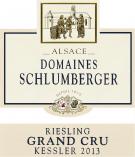History
Mentioned as early as the year 1394, the Kessler has been marketed under its own name since 1830.
Location
The Kessler grows on a sandstone soil and displays in its centre a valley that is globally facing east, south-east, which protects it from north winds and cold air streams brought by the valley of Guebwiller. As a natural extension of the Grand Cru Kitterlé, its subsoils are reddish over Vosgean sandstone bedrock. At its base, an outcrop of limestone results in clay soils.
Wine-making
Whole grape pressing, static racking. Fermentation in thermocontrolled tuns for 1 to 4 months. Ageing on fine lees for 8 months.
Gastronomy
I like to associate this wine with Asiatic cuisine, salmon sashimi or a spicy gambas salad. Ideal with a frog mousseline with Riesling sauce or fresh goat cheeses such as a crottin de Chavignol. Serve at a temperature of 12°C.
Learn more about food & wine pairingTasting
The robe is a pale yellow, with light green reflections of average intensity. The disk is bright, limpid, transparent. The wine shows a beautiful youth.
The nose is frank, pleasant, intense. Elegant, one perceives domianants of fruity scents, citrus fruits, lime, as well as spices, ginger. Airing enhances the previous aromas and reveals a fine, empyreumatic, complex flinty hint. The nose shows a good grape maturity. At this level of its evolution, the profile is slightly reserved. Time will give it its dimension.
The onset in the mouth is moderately ample, the alcohol support is balanced. One evolves on an incisive and sharp vivacity marked by a sparkling note. The range of aromas is reminiscent of the nose, dominated by citrus fruits, lime, spices, ginger, and still this underlying smoky flinty hint. One can feel a slight bitterness. The finish has a good length, 6-7 caudalies and a frank, persistent vivacity.
The balance of this wine is sharp, vertical. The still young range of aromas requires time to open out, to settle itself. Patience.
Technical sheet by M. Pascal Leonetti
“Best Sommelier of France 2006”

















